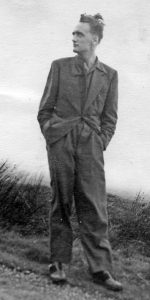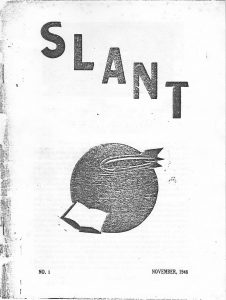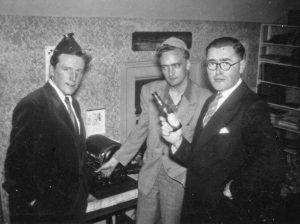Today we bring you Part 1 of Then, the history of English and Irish fandom that’s been especially edited for us by author Rob Hansen. These extracts provide an amazing account of how Irish fandom developed, and we really hope you enjoy the series! The prologue, as well as links to Rob’s original, and more detailed account of fandom in the UK and Ireland, can be found at the bottom of the page.
1. Belfast Rising
When Walter Alexander Willis first appeared in fandom there was little to indicate how important and influential a figure he would become. Belfast was far removed geographically from the fannish mainstream but Willis and the other fans in that city were to make Irish Fandom the most celebrated fan group of the 1950s. It all began on a rainy afternoon towards the end of World War II when Willis and the girl he’d been dating for nearly a year, Madeleine Bryan, took shelter in a newsagent’s. Only when they reached simultaneously for the same copy of a BRE ASTOUNDING did each realise that the other read SF. “I think I first realised his intentions were honourable, when he started to let me read the novelette first”, Madeleine later remarked of that day. They married in 1945 and bought a house, 170 Upper Newtownards Road, that would eventually be known as ‘Oblique House’ and become one of the most famous fannish gathering places of all. Irish Fandom had not been born yet, however.
A windswept Walt Willis.
All images courtesy of Rob Hansen
In the summer of 1947 the Willises discovered, in a second-hand bookshop on Austin Street, something whose existence they had not previously suspected: a US edition of ASTOUNDING. This led to a frantic scouring of Belfast and surrounding districts that didn’t produce any other issues but which did turn up a copy of Walter Gillings’ prozine FANTASY. In the letter section was a
missive from a Belfast fan, one James White. Walt Willis wrote to him and White replied on 26th August, a day thereafter known as Irish Fandom day, and arranged to meet. The group had been born, but for the first few months they were content to do little more than read through each other’s books and magazines and to combine their collecting efforts. In December 1947, Willis came across an ad for the British Fantasy Library in one of the prozines and wrote off for details. The reply came in the form of a scribbled note from Ron Holmes and a mess of duplicated BFL material, including OPERATION FANTAST. Since OF offered magazines that Willis wanted he got in touch with editor Ken Slater about them and also asked if Slater could put him in touch with any other fans in Belfast. He couldn’t. In March 1948 the third OF appeared, and among its enclosures was a copy of the first issue of Norman Ashfield’s fanzine, ALEMBIC. As Willis recalls:
“It was this that started me off as a fanzine publisher, for Madeleine
held it up and said, ‘Surely you could do better than that!’, and I
thought maybe I could. It wasn’t that we had such contempt for ALEMBIC, it
was rather that it was more our sort of thing than OF had been. OF had news
items and all sorts of proper magazine stuff, whereas ALEMBIC was just
comments and general talk by Norman. Besides, this was only the second
fanzine I’d seen, and it made me realise that there was no closed
shop.”
Irish Fandom’s first fanzine was to have a prolonged gestation, with early difficulties being encountered with the printing:
“When I’d got the draft typed up I made enquiries as to how much it would
cost to have it professionally duplicated. Then the project was quietly
abandoned. Until one afternoon a week or so later I happened to call on a
friend who worked in a chemist’s shop. I went up to the attic to help him
sort out the junk while we were talking, and I came across an odd looking
metal box festooned with levers. It was a little printing press the boss had
bought ages ago to run off billheads, and then dumped in the attic and
forgotten. I borrowed it and smuggled it out under my coat, along with a
composing stick and all the type we could find.”
With a printing press to hand, even such a rudimentary flat-bed, Willis and White set to with enthusiasm, White even going so far as to produce ‘woodcut’ art for the issue using plywood and a razor. After “some 100 hours backbreaking toil” they had produced the first issue of SLANT, a 12-page half-foolscap production. Now all they needed to do was distribute it. To this end Willis had decided to take advantage of the BFL’s offer to distribute fanzines with its own BOOKLIST and in September had written to John Gunn enquiring as to the next mailing, which was scheduled for 15th October 1948. SLANT was ready by 11th October so Willis asked if it could go out with the mailing. There was no reply, and the mailing was duly dispatched on 20th October. On receiving it, Willis wrote asking for the next mailing date and offering to pay part of the mailing costs. Again there was no reply, and that mailing went out on 9th November. Willis wrote yet again, this time offering to send the next mailing out for Gunn (he and White couldn’t send out SLANT themselves — they had no addresses). Consequently, a parcel arrived on Christmas Day containing 200 copies of the December BOOKLIST and what Gunn’s covering letter described as “the only copy of the Directory of Anglo-fandom in existence”. As Willis recalls:
“There was neither stamps nor money enclosed, and indeed we never did get
any recompense for the cost of the mailing, but it didn’t matter anyway
because there was no postal collection until after Boxing Day. We spent most
of the intervening time writing addresses and sticking wrappers for about
150 people — the 49 noted as fully paid-up members of the BFL plus 101
others chosen more or less at random — and on 27th December 1948 the first
fanzine ever published in Ireland was released on an unsuspecting
fandom.”
A largely positive response to SLANT provided the impetus for a second issue but as it was nearing completion it looked as though it was going to face the same distribution problems as the first issue had. By now the UK’s latest national fan organisation, the Science Fantasy Society, was up and running and Willis was eager to have SLANT 2 sent out with its official
organ SCIENCE FANTASY NEWS but again things dragged on for months and though SLANT 2 was ready in May it was July before it went out. The problem was that SFN editor Vince Clarke was already taking most of the running of the SFS on his own shoulders, and illness had delayed SFN 4. By way of a subscription, US fan Eva Firestone had enrolled Willis in America’s NFFF after the first SLANT and the NFFF membership roster provided the fanzine with a US mailing list. This was Willis’s first link with US fandom, a link that was to contribute much to fandom in the 1950s.
SLANT Issue 1.
The third SLANT proved no easier to get out than its predecessors. Willis and White were toiling away in order to meet the 19th December date given by Ted Tubb as the deadline for inclusion in the bumper SFS Christmas mailing, when disaster struck in the form of the impression lever on the press shattering as the last page was being produced. Later, in an amazing act of generosity, US fan Manly Bannister was to make a gift of his own press and ship it over to Irish Fandom, but meanwhile they had a problem. Willis had to ask Ken Bulmer to run the last page off on the Epicentre’s newly-acquired rotary Gestetner, the Epicentre being the flat in London’s Highbury that Bulmer shared with Vince Clarke. Then there was the problem of distribution. In a replay of the previous Christmas, Willis had volunteered to send out the whole of the Christmas mailing from Belfast:
“Ghod knows why: partly out of innocent helpfulness I suppose and
probably partly so I could make sure that the good copies of SLANT went to
the right people. Anyhow, it was a mistake.”
From the Epicentre came copies of the Gestetnered back page of SLANT, address labels, lists, ALEMBICs, SFNs stapled and loose, SFS Christmas cards, BFL Newsletters, and copies of Bulmer’s fanzine, NIRVANA (a publication that only ever saw one full issue, mentions of apparently limited-distribution later issues being a hoax). It was hard work but Willis eventually got them sorted and mailed out.
Early in 1950 Irish Fandom acquired a new member when a hitherto unknown Northern Irish fan was contacted as a result of a letter he had printed in Gillings’ FANTASY REVIEW. This was George Charters, and though he visited the group at Willis’ invitation it would be a while before he became more than just an occasional visitor.
Response to SLANT 3 was disappointing but in March 1950 Willis received a momentous letter, not that it appeared that way at the time. It was a request for a subscription that began “Dear Mr Ellis…”, and its writer was Chuck Harris. The following month Willis received a fanzine containing a story by Harris that impressed him sufficiently to ask Harris to submit one to SLANT. “You really startle me”, Harris jokingly replied, “do you mean you’ll consider publishing a story by me without paying me for it?” As Willis remembers:
“The story when it arrived turned out to be about a werewolf who picked
up a girl in India who when confronted by a death worse than fate turned out
to be a weretiger. James White saw the gimmick after the second paragraph
and I told Chuck this when rejecting the story, which was the beginning of
the great White/Harris ‘Feud’. At about this time Chuck had a regular thing
about werewolves and produced the first line of a story about a whole group
of them which was really a classic among first lines: ‘The family were
changing for dinner’…”
In the autumn of 1950 Willis visited England. One of those he had hoped to visit was Chuck Harris, but it was not to be. On 24th August Harris wrote to Willis and revealed what he’d hitherto kept a secret:
“…I don’t think you’ll be seeing me when you come over. During the war
I caught meningitis, whilst in the Navy, and it destroyed both auditory
nerves. Hence I am completely deaf. Lip-reading is a very exacting science
(harder than Dianetics!) and I’m not very proficient. Most of the
‘conversation’ has to be written down for me, and it makes things rather
difficult.”
Willis took the boat to Liverpool where he visited Eric Frank Russell. Then it was on to Leicester to stay with Mike Tealby, editor of WONDER. Here Willis made a note of the name of an unknown Belfast fan who had written to Tealby, the then British agent for OPERATION FANTAST, enquiring about whether there were other fans in that city. He also put out a one-shot fanzine with Tealby, SLANDER. This was a combination of the names of their regular fanzines (SLANT + WONDER) and carried a semi-serious attack on the London Circle, whose inactivity had long been a source of irritation to provincial fans. The culmination of Willis’s trip was a visit to London. Arriving on a Thursday he met Vince Clarke and Ted Carnell in a J.Lyons teashop and then went on with them to the White Horse:
“I don’t remember much about that, but afterwards Ken and Vin? invited me
to stay at The Epicentre, and I do remember that. It may have changed
my whole life, and it certainly changed my writing style. Hitherto
everything I’d written had been either serious and solemn or tense and
turgid, but within a few weeks of getting back I was writing…more or less
the way I write now. Yes, I had spent a night at The Epicentre and I had
become a fan.”
Bob Shaw, Walt Willis and James White
On 10th October 1950 the Belfast fan whose name Willis had noted while staying with Mike Tealby showed up at Oblique House.(“The Belfast Triangle is…now a quadrilateral” he wrote in a letter to The Epicentre later). A 19 year-old, this newcomer turned out to be an artist and a writer, and keen to get involved with fanzines — all in all a valuable addition to Irish Fandom. He went on to produce what are probably the most famous of all the SLANT contents, the much-reprinted ‘Fanmanship Lectures’, which tell how to achieve Big Name Fan status by means of various Machiavellian techniques. His name was Bob Shaw.
-Rob Hansen
‘Then’ on the Dublin 2019 Blog:
Rob Hansen’s Then (A work always in progress) at Ansible.




